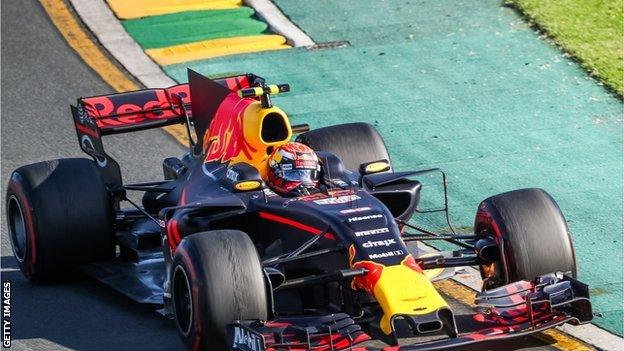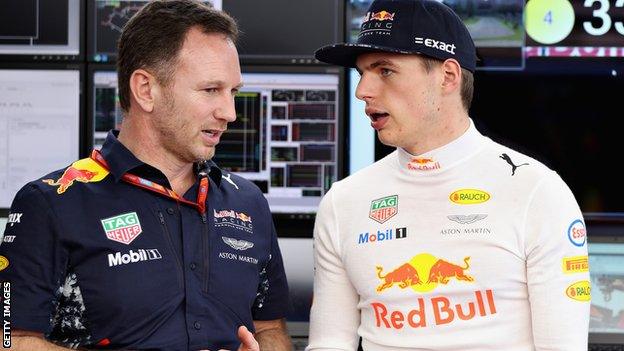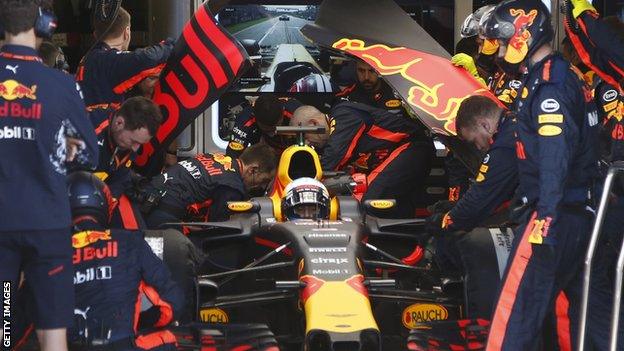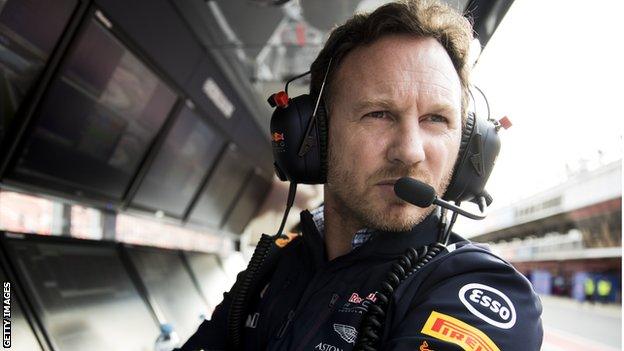Red Bull: The key areas where Christian Horner's team need to improve
- Published
- comments

Max Verstappen finished fifth in Melbourne for Red Bull while Daniel Ricciardo was forced to retire
Red Bull were one of the prime movers behind the push for faster, more demanding Formula 1 cars this season, so it is somewhat ironic that they started the season off the pace of Ferrari and Mercedes.
All is not lost, however, for the team that just over three years ago were celebrating their fourth consecutive world title double.
Red Bull were the only team to beat Mercedes last year and finished second in the championship. But although Red Bull were clearly the third best team in Melbourne, there is good reason to believe they will make it a three-way fight at the front in 2017.
Red Bull admit they have work to do with both their chassis and the Renault engine, but improvements to obvious faults are on the way.
The situation
Red Bull qualified 1.3 seconds off pole position in Australia. Which sounds a lot - indeed, it is a lot. But it is worth bearing in mind that last year, which they ended with two victories and could have had three, they were 1.6 seconds off the pace at Albert Park.
In the race, their pace was hard to judge - Daniel Ricciardo was never really in it after what team boss Christian Horner said was a "weekend from hell". And Max Verstappen spent much of the afternoon bottled up behind Ferrari's Kimi Raikkonen.
There were only a handful of laps in the first stint in which Verstappen was more than two seconds behind Raikkonen - the gap at which drivers say their car starts to be affected by aerodynamic turbulence from following another car.

Max Verstappen was about 0.7secs off the pace of leaders Lewis Hamilton and Sebastian Vettel in Melbourne
On average, on those 'clean-air' laps, Verstappen was about 0.7secs off the pace of leaders Lewis Hamilton and Sebastian Vettel.
After his pit stop, the Dutchman was pretty much on the leaders' pace - sometimes quicker, sometimes slower, sometimes about the same - but then the picture was skewed by the fact that he was on a softer, faster tyre.
In all, Horner reckoned Red Bull needed to find "a good half a second to get into that fight with the cars ahead".
The engine
Coincidentally, 0.5secs is about the margin Red Bull believe they are losing as a result of the Renault engine in race pace - and as much as 0.6-0.7secs in qualifying.
The Renault, which has been redesigned for this season, has had reliability problems this year and fixes for these had a direct impact on performance in Australia.
Primarily, Renault were suffering in pre-season testing with overheating of the MGU-K - the part of the hybrid system that recovers energy from the rear axle.

Red Bull believe they are losing as much as 0.5 seconds because of their Renault engine
The temporary fix for this was to use last year's MGU-K, which is 5kg heavier than the 2017-spec design and also requires an extra air bottle, which is at least another 1kg.
That weight accounts for about 0.2secs in lap time itself, and a revised version of the new MGU-K is set to be introduced for the fourth race of the season in Russia.
Renault will then introduce a major upgrade for either Monaco - the sixth race - or, more likely, the subsequent event in Canada. This is referred to by Red Bull as "significant" - which is code for about 0.3-0.4secs in lap time.
The chassis
Horner said the lap-time deficit of the Red Bull-Renault to Mercedes and Ferrari was "probably an equal share" between car and engine.
And it was clear the Red Bull was far from its best in Australia. Both drivers struggled to find the right set-up - complaining of the balance switching too easily between extremes.
The car, in its current form, has what is known in F1 as "a narrow set-up window" - it is hard to home in on the correct balance - as well as a performance shortfall to the Ferrari and the Mercedes.
But Horner says: "It's still early days. The regulations are still very immature. We've chosen a different concept. I believe there's really good development potential in the concept that we have."
What does he mean by "different concept"? The key is in the aerodynamics - and particularly in the design of the front wing.
In all F1 cars, the front wing is crucial in setting up the airflow around the rest of the car. It creates what are known as vortices that sweep around the sides of the car and then under the floor in front of the rear wheels. The faster these vortices can be made to travel, the more aerodynamic downforce will be created by the floor between the rear wheels.

Red Bull's inner flaps point upwards, in order to direct the airflow higher up around the car.
These vortices start at the inner tips of the flaps on either side of the front wing. Most teams send them between the front wheels and over the various fins and curved plates that can be seen in front of the side pods - the bodywork either side of the cockpit.
But because it is so crucial that the airflow hits all these pieces of bodywork, that means that overall downforce of the car can be badly affected in less than perfect conditions - such as in a cross-wind, or in traffic.
The Red Bull has far fewer of these additional pieces of bodywork than the other front-running teams, and that's a conscious choice by Red Bull's aerodynamic team under chief technical officer Adrian Newey.
They wanted a car that was more consistent in changing conditions. The key to the way it differs from other cars can be seen in the front wing.
On the Mercedes and Ferrari, the inboard ends of the series of flaps on either side of the wing point downwards towards the wing mainplane.
Red Bull's inner flaps point upwards - because they are directing the airflow higher up around the car. That means there is reduced need for the intricate cascading flaps downstream.
It's a classic example of the philosophy long-espoused by Red Bull design chief Newey, whose genius resides in not only producing great performance, but also in doing it in a manner which means the driver can access more of it more of the time.
The performance is not there at the moment, but as Horner put it: "I think development is going to be incremental at every event. Looking at the amount of notes Adrian has taken away from this weekend, for sure it's going to keep our design office pretty busy."
Can Red Bull catch up?
Last year, after Red Bull were 1.6 seconds off the pace at the first race, Max Verstappen won the fifth race in Spain.
That win was only possible because Mercedes drivers Hamilton and Nico Rosberg crashed out on the first lap. But two weeks later, Daniel Ricciardo took a brilliant pole in Monaco and would have won but for a delay caused by a pit-stop mix-up.

Red Bull's Christian Horner says his design team will be "pretty busy" in the wake of the Australian Grand Prix
From then on, Red Bull were usually Mercedes' main challenger - Ricciardo again came close in Singapore and then did finally win a week later in Malaysia, albeit this time after a Hamilton engine failure.
At this early stage, the pattern looks very similar - a deficit in Australia, a major engine upgrade at the sixth or seventh race, consistent chassis improvements.
On that basis, it is easy to believe Horner when he says: "There's a lot of positives to take out of Australia, at a track where we have not been competitive for the last couple of years. I'm sure that we can build on this over the coming races.
"We have a good basis and a good direction and as the regulations are quite immature, I think things will move quite quickly. So I honestly believe we will get ourselves into a competitive situation this year."